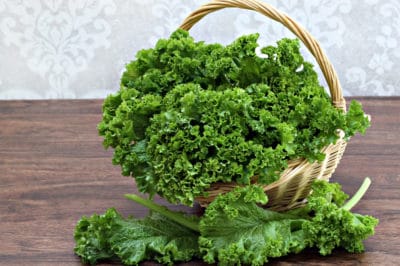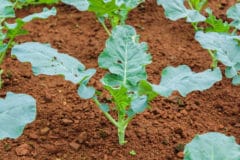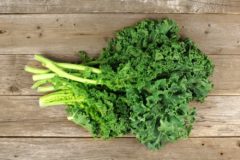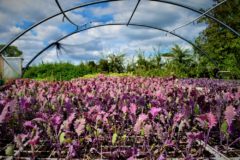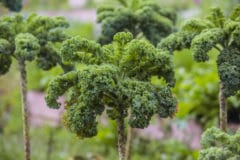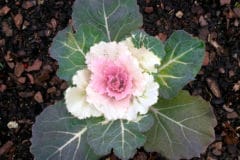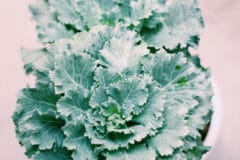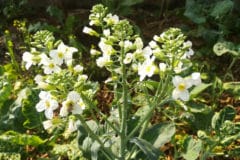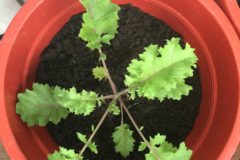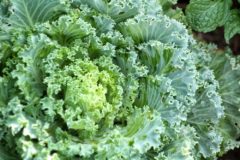Growing Kale for Different Stages of Harvest
Kale can be used differently if picked at different stages of growth.
Growing Kale Sprouts
Kale sprouts, and any other type of sprout, are referred to collectively as micro greens, and kale sprouts can be grown from any variety of kale.
To grow kale sprouts:
- Plant the seeds in a shallow container at a depth of 1/4 inch.
- Pack the seeds so closely together that when they sprout, they form a solid carpet of green leaves.
Growing Baby Kale
Again, baby kale can be grown from any variety of kale, and it can be grown indoors or outdoors.
To grow baby kale:
- For growing baby kale indoors, choose a smaller container than you would need if you were growing full size kale.
- Indoors or outdoors, space your plants closer together, at 6″ apart instead of 12″ to 18″.
Growing Mature Kale
While dwarf kale varieties can be grown indoors, most varieties are about 2 feet in diameter and 2 feet to 3 feet tall. You can grow plants this large indoors, but given that you need two to three plants for each person in your household, you might want to grow mature plants outdoors to make sure that there is still room for you and your family indoors.
Harvesting Kale
The real difference between kale sprouts, baby kale, and mature kale is a result of when and how the kale is harvested.
Harvesting Kale Sprouts
When you are growing kale sprouts, the first leaves that appear are not actually the true kale leaves. They are the cotyledon which are part of the seed. They provide nourishment for the plant until the root system and true leaves develop.
If you are growing kale sprouts, though, you harvest your kale at this stage. Simply pull the plants up out of the potting soil and rinse them.
Sow more seeds as you harvest to create a continuous supply of sprouts.
Harvesting Baby Kale
Gardeners have several choices on how they harvest baby kale.
Picking Baby Kale by the Leaf
If you plan on harvesting individual leaves of baby kale, wait until four true leaves have developed at the top of the plant and more leaves have formed below the top four. Don’t take your entire harvest from one plant. Instead, pick leaves from several plants, leaving about one-third of the leaves on each plant along with the top four leaves.
Harvest the lower leaves from the ground up before they reach the size of your hand. Peel the stem of the leaves down from the stalk, and leave no stems, or as little of the stems as possible, on the plant to prevent them from rotting and providing an entry point for disease.
Rinse the leaves after picking them, and then, if you are growing your kale outdoors, soak them in cold water for an hour to remove any caterpillars.
If you are harvesting your kale this way, always leave the four leaves at the top of the plant so that it continues to grow and produce.
Harvesting Baby Kale by the Plant
Alternatively, you can harvest your baby kale as you would harvest a head of cabbage or lettuce. Cut the stalk off 2″ to 4″ above the level of the soil. Strip the leaves off of the stalk after cutting it, and, again, rinse and soak them. Leave the remainder of stalk in the soil, and new leaves will begin to form in one to two weeks.
Harvesting Mature Kale
Mature kale is ready to harvest when the leaves are about the size of your hand. While you are harvesting your kale, remove overly mature yellow or brown leaves and compost them or discard them. Also, take the time to inspect your kale for pests.
As with baby kale, leave the top four leaves and about one-third of the rest of the leaves on the plant. Pick the leaves from the bottom of the plant up by peeling the stem from the stalk with a downward motion. Remove all of the stem, or as much of it as possible, to prevent rotting and disease.
Because kale leaves become tougher and the flavor becomes more bitter as they mature, especially if the mature kale has been growing in temperatures above 80° F (27°C), you might want to harvest up to 90 percent of the leaves or harvest the entire plant before the heat of summer hits.
To harvest the entire plant, just cut the stalk 2″ to 4″ above the top of the soil. New leaves will begin to appear within a week or two.
Before using the leaves, rinse and soak them.
Storing Kale
If you pick more kale than you need for one meal, you can safely store either baby kale or mature kale leaves by placing them loosely in a plastic bag. You can keep them in the crisper drawer for about a week.
